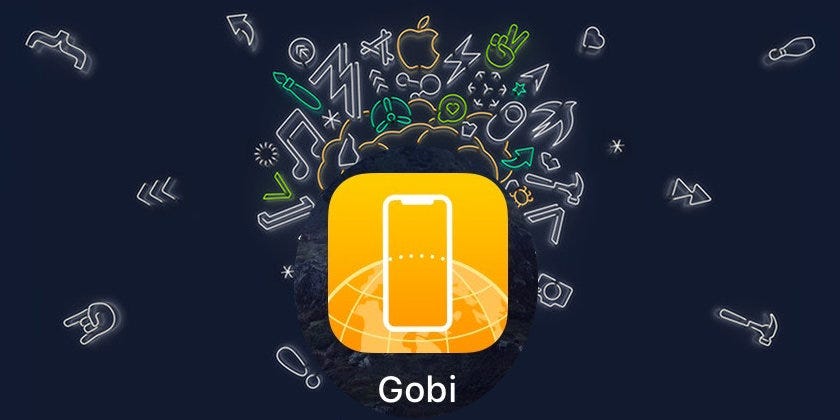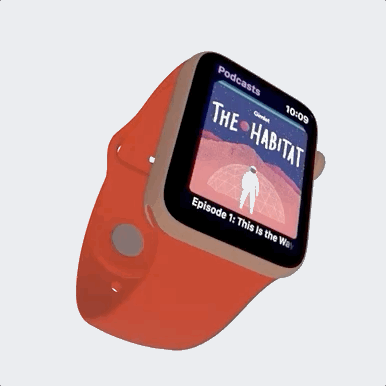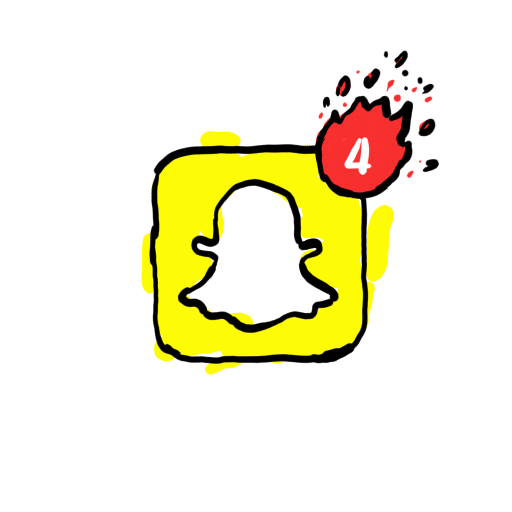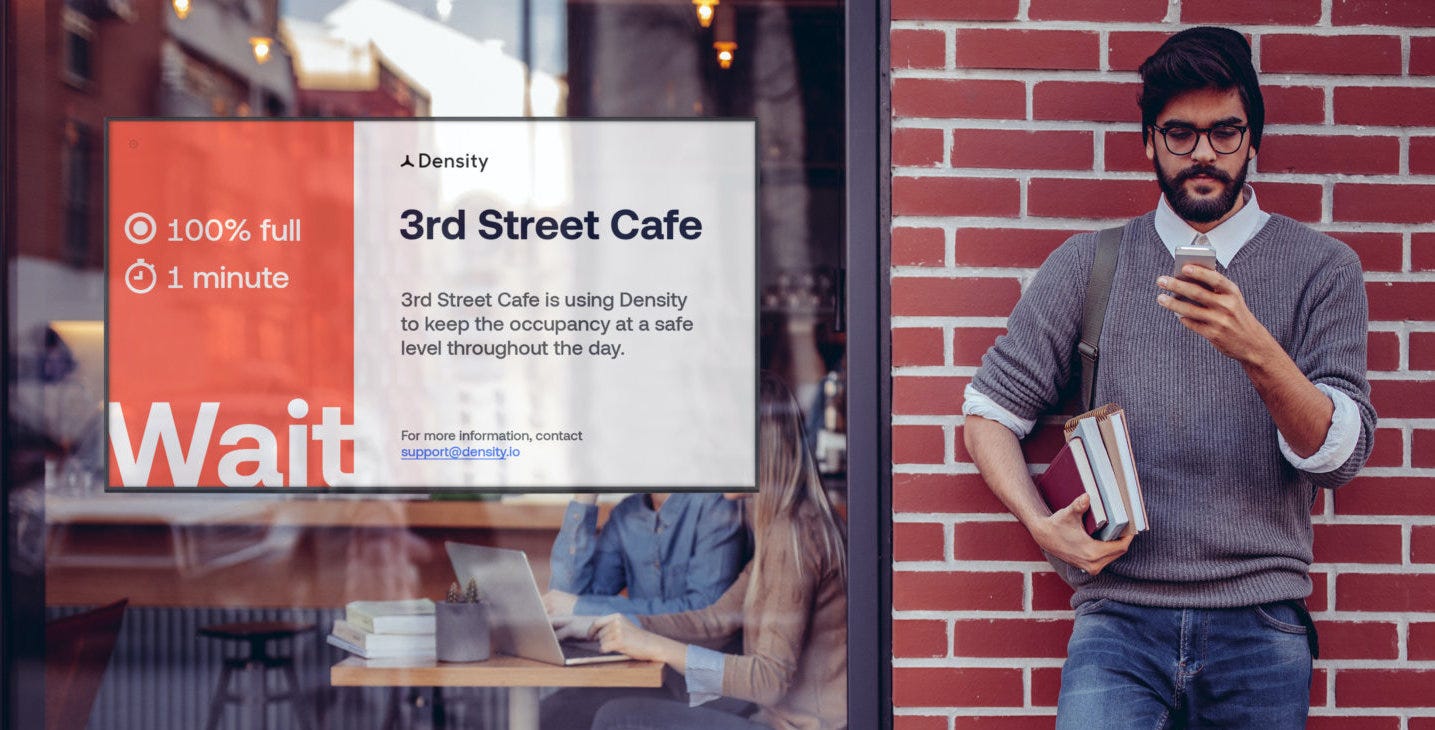Leaked pics from Apple's AR app Gobi
Plus, experts discuss GIPHY's Facebook buyout and if it ripped off artists

I couldn’t resist giving you a scoop today even though it’s been two weeks since I technically left journalism to be a VC at SignalFire. This newsletter is rapidly evolving so reply with feedback about what you want to see in Moving Product.
Apple is embracing the camera as a utility with a new augmented reality app called Gobi and new AR features in its Find My app. A source has provided me with a dump of leaked files from iOS 14, expected later this year. They reveal Apple-branded QR codes with a colorful new format, a preview of Gobi’s Starbucks partnership, and how Find My will use sound & haptic feedback to point you in the direction of your missing device.
These new finds build on what 9to5Mac’s Benjamin Mayo reported in March, including the Gobi name, and the first signs of Find My AR from MacRumors last year. Apple didn’t respond to a request for comment.
Here’s what’s new for Gobi:
The app icon seen here:

What appears to be a flashy new QR code format that uses colored cones of varying sizes instead of a matrix of dots. One of the files was labeled “Cosmic” while there were also 100 “tags” with different alphanumeric codes.

Apple-branded traditional QR codes that show its interest in camera-triggered commerce. Files in Gobi included QRs that opened the Mac Pro and Apple Watch websites, the Star Wars: Rogue One movie in the iTunes Store, and one that opens the Starbucks Card sign-up flow (Update: Unknownz21 tweeted the Starbucks QR a week ago).
References to a Gobi comparison shopping feature for Apple stores that leads to a broken link for https://www.apple.com/retail-compare plus a 3D rendering of an Apple Watch that users could spin and examine.

Code indicating that the Gobi app could score users discounts at Starbucks locations. — "M01": { "storename": "Starbucks Sunnyvale", "promotion": "20% discount" } — The files included the latitude and longitude of 6440 Starbucks stores around the world, suggesting Gobi could use geo-fencing to know when to offer a promotion or content experience.
A mysterious image titled “Sbux_Preview” of what appears to be an augmented reality pagoda tower atop a small table, that could show how AR might spruce up the decoration of the cafes while giving visitors something to play with.

And in the Find My app:
A hip little video file of a retro 3D Apple logo spinning around while Slyrax’s “Awaken” plays.
Audio files and haptic feedback code that reveal how the Find My app will give you sound and vibration cues to locate your missing devices. You’ll hear encouraging sounds when you face the right direction so the lost gadget is “Ahead” of you, when you’re “Nearby”, or come within “Arms Reach”, while discouraging tones hint that you’re headed off course.
You can watch the video, hear those sounds, and watch a GIF of all the colored QR codes in the video I made below.
While AR for entertainment has gone mainstream with Snapchat’s selfie filters, we’ve only seen a few popular utility use cases like a virtual measuring tape or seeing what furniture would look like in your house. But Apple AR experiences for dining, shopping, and finding those damn AirPods in the couch could popularize the technology and make people curious about what’s hidden in the digital plane overlaid on the world around them. Expect a lot more camera-triggered commerce from Apple. Once these behaviors become common, there could be opportunities for developers to build more niche or exciting ways to augment our lives.
Facebook buys GIPHY’s spies

The future of communication is visual, as people seek quick and convenient ways to share what they’re doing and feeling without laboring over text. If a picture’s worth a thousand words, a GIF is worth a thousand pictures, and that data’s worth even more. Two approaches to visual communication have evolved in parallel. The first is camera-based, as popularized by Snapchat’s rapid-fire photo & video messaging where selfies and quick clips replace long-winded text that younger users especially find to be a chore. The second is non-camera visual comms, which use GIFs, memes, or personalized avatars to let users convey nuanced thoughts by choosing from pre-made or procedurally generated media.
Along with social media, the tech giants want to own as many of these visual communication formats as they can. Hence, this week’s $400 million acquisition of GIPHY by Facebook, though it’s coyly being messaged as GIPHY joining Instagram, perhaps to preserve the GIF company’s ‘cool’ or seem less concerning to anti-trust regulators (who honestly should be worried).
The visual communication scoreboard
Visual messaging - Winner: Snapchat. Challenger: Instagram
Short biographical video & photos - Winners: Instagram, Facebook. Runner-up: Snapchat
Links & the heterogeneous feed - Winner: Facebook. Runner-up: Twitter
Mid-length, high-production video - Winner: YouTube. Challenger: Instagram
Streaming - Winner: Twitch. Runners-Up: Instagram Live, YouTube
Microentertainmnt - Winner: TikTok. Challenger: Instagram Reels, YouTube Shorts
Memes - Winner: Instagram. Runners-Up: Twitter, Imgur
Avatars - Winner: Snapchat’s Bitmoji. Challengers: Facebook Avatars, Genies
Shallowfakes (GIFs + your face): Winner: Snapchat Cameo. Challenger: Morphin
GIFs - Winners: Facebook’s GIPHY, Google’s Tenor. Challenger: Gfycat

Some of these products like TikTok and Instagram act as destinations, where creation, consumption, and monetization all happens within an app. There, what matters is total users, engagement, and effectiveness of ads. But GIPHY is more of a developer platform and two-sided marketplace than a destination. It connects content from artists and media companies with developers that embed GIPHY’s search engines in the apps you use.
There are certainly opportunities to monetize platforms like GIPHY by selling sponsored placement of certain brands’ content atop search results, as the startup had tried. The owner of one of these platforms, like Facebook, could also make these developer tools exclusive to their own apps to attract users and increase ad views. But Facebook’s not likely to shut off GIPHY for partners like Twitter, though it might reserve the best integrations and skew the product roadmap for its own apps’ benefit, because there’s another way to win: data.
GIPHY’s data = the culture graph
Facebook lost some of its best market surveillance tools last year in the wake of my report that it was quietly paying teenagers $20 a month to siphon all their data. That led to shut down of its VPN Onavo and its Research app that both let it see what competitors’ apps and features people were using.
But GIPHY could let it learn about what apps are growing quickly (increased GIPHY searches), what types of content or influencers it might want to add to Watch or its Live streaming deals (what’s searched for), what visual media is most appealing (which GIFs get picked), and possibly tie this interest data to users’ identity (since developers have to send device Tracking IDs to GIPHY).

Facebook and Instagram could use GIPHY data to build out a dedicated meme feed or app — a successor to LOL (above) which it built for teens but then scrapped last year. Right now, memes are popular on Instagram but crammed in alongside traditional photos & vides from friends, influencers, and interests. By combining its own data with what GIFs people use, Facebook could build out a ‘culture graph’ of what movies, shows, games, bands, influencers, and subcultures people care about. That could let it smartly rank a dedicated meme feed that could encourage users to share more visual comedy. I’d also expect Instagram to build a modern version of GIPHY Capture for letting people clip their own GIFs from videos.
Product Roundtable: What FaceGIPHY means
I asked some top social product thinkers for their opinion of the deal.
The Venture Twins aka Justine and Olivia Moore, investors at CRV and authors of the Accelerated newsletter:
“GIPHY is less of a ‘browsable’ feed and more of a destination to search for a specific piece of content, find it, and leave the platform. And while a big brand like Coke may pay for awareness (e.g. a Coke GIF pops up when users search for ‘refreshment’), many advertisers are looking for direct response ads, which can’t be done on GIPHY. Given GIPHY’s struggle to monetize as a standalone platform, it makes sense that they pursued an acquisition from a larger social player.
Anything Facebook and Instagram can do to make GIF usage easier boosts value-add to users - especially as Snapchat still has strong Gen Z usage, and TikTok poses more of a threat. If they keep the API running, Facebook may also get valuable data on what users are looking to post on other platforms via GIPHY. We could also see a GIPHY integration as another attempt to make IGTV ‘work.’ One of IGTV’s biggest problems is that the content isn’t accessible/previewable, especially on a platform like Instagram that is made for short-form content. If content creators (or users) could easily GIF and share great IGTV moments, this could direct more traffic to these videos.”
Avatar startup Genies’ CEO Akash Nigam:
“So first off, I am very close with Alex [Chung, GIPHY’s CEO], and believe he is one of the underrated great CEOs of our consumer generation. He and Adam are going to mesh very well, and Alex will have direct impact on Instagram’s product roadmap in no time, promise you that.
Overall, I think FB x GIPHY was inevitable, but the pandemic accelerated the relationship. Online expression is no longer a Gen Z or millennial thing, it’s now a mandate for all humans. They could experiment with heavier, supercharged editing tools that starts to spur similar TikTok culture onto Instagram. Gen Z is more comfortable in front of the camera than any other generation and needs all the editing bells and whistles they can get. Now that the world is coming to the realization we are going to be online ‘forever’, I feel like there’s going to be revolution of ‘format inventions’ similar to when Boomerang was first created.”
Did GIPHY rip off GIF artists?
But then I got a very different perspective from an animation startup founder and GIF maker who’s been waging a campaign against the startup for years, accusing GIPHY of piracy.

Pasquale D’Silva, CEO and “co-flounder” of animation studio Thinko:
“GIPHY’s acquisition by Facebook is built on nothing short of theft. The initial core product was stealing GIFs from Tumblr artists, creating fake accounts for them, and shopping around a search engine combined with this stolen data. Not only have they violated Tumblr’s Terms of Service, but have also stolen property from artists without consent. When confronted by this, staff at GIPHY told artists the same sob story: “We’re not profiting off anyone anywhere. We have no income” They sold for 400 million dollars.
While they mention folks can file a DMCA takedown, this does not reverse the fact that GIPHY redeemed the work of artists in exchange for driving up company valuation. The acquisition represents an awful precedent for not compensating artists. This predatory company should be held accountable. GIPHY employees are receiving option exercise agreements, yet artists are receiving nothing. I encourage anybody who has had their work scraped and distributed by GIPHY without consent to come forward.”
For years, multiple sources say GIPHY would scrape Tumblr GIFs, rename the files as giphy.gif, and make them available with no attribution. Later it encouraged artists to claim profiles of their GIFs. But it’s still tough for an end user to find out who made the GIF they just tweeted. GIPHY has cleaned out some scraped GIFs from its search engine and launched programs like GIPHY Arts. Some experts like Techdirt’s Mike Masnick thinks GIPHY’s actions are legal as Fair Use. But there’s room for an investigative journalist to dig in here. Creators are still pissed.

“People who value execution sometimes say ‘ideas are worthless, what matters is execution’. Sometimes it means ‘I'm going to steal the property of an entire industry, claim it's mine, make pennies on the dollar and become rich while the people whose work I illegally stole to build my business struggle to make rent’” multi-million-view GIF artist and startup founder Ronen V tells me. “Some GIPHY guy proudly showed me his business card, which had my poor friend's gif printed on it being used without permission to represent their business. I asked who made it. He said the printer. ‘I mean the GIF’. He said ‘no idea’. I handed the criminal business card back to him and said ‘exactly’.”
If Facebook wanted to try to make amends (and discourage a potential class-action lawsuit if jilted artists band together now that GIPHY has a deep-pocketed sugar daddy), it could link GIF stickers on Stories and elsewhere to creators’ Instagram accounts. After years of failing to break bread with them, at least that would help GIF artists build an audience.
Product of the week: Safe by Density
Density makes sensors that can tally room occupancy without facial recognition. Now for the COVID epoch, it’s built these ‘Safe’ public dashboard displays so buildings and businesses can show when they’re full and how long you might need to wait.



It can also tell building managers when rooms need cleaning, when attendance spikes so they can smooth out demand, and which spaces go unused and could be repurposed. Products like this that serve both an obvious public safety purpose but can also make businesses more efficient are the kinds of market-driven win-wins we’ll need to rapidly adapt culture to coronavirus life.
And your meme of the week…
…is actually a pretty savvy product of its own. Maskalike will be making masks with your face on them so you don’t have to look like an anonymous ninja. For starters, they’re printing ones so you can look like Harold, the stock image model for thinly-veiled insanity — fitting for all current occasions.

Thanks for joining Moving Product. Reply with feedback or cool products I should feature!





Bye the way. Fix your hair again. You look like a band boy wanttabe.
You got OWNED by Steven Crowder!!